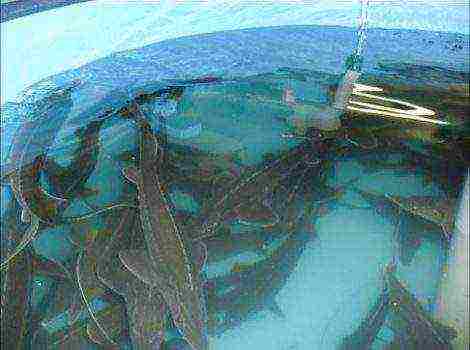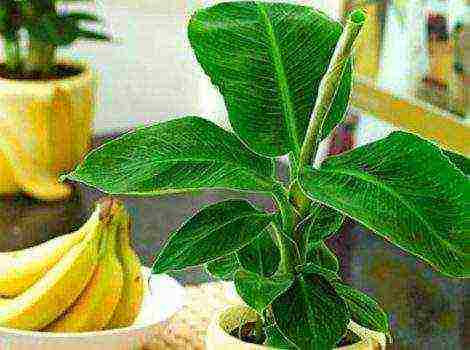Content
Peas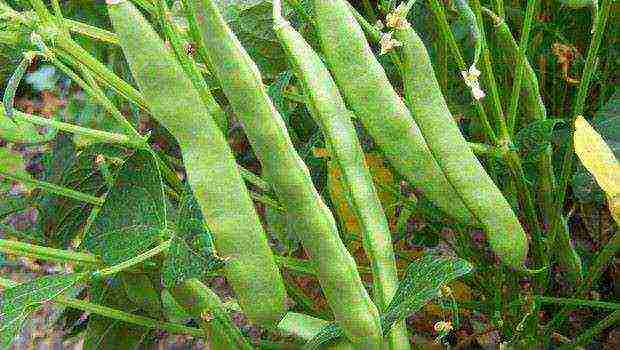
Published by 06.01.2015 |
How to grow beans in your backyard
Beans have been cultivated by humans since prehistoric times. China is considered their homeland, where the seeds of beans were the basis of the food of the peasants. Until the middle of the 20th century, beans spread throughout the world, and their taste and nutritional value were appreciated. Although beans are classified as field crops, summer residents and gardeners currently grow them on their land plots.
Characteristics and properties
The bean bush branches under favorable conditions and reaches a height of 1 m, the stem is erect, the root system is up to 1.5 m. The appearance of the seeds resembles beans. The yield depends on the variety and growing conditions and can range from 300 g to 1 kg, and with proper care, up to 1.5 kg per square meter.
In order to grow beans on your site, special skills are not required, this culture is unpretentious and frost-resistant. Their optimal growth is observed at 15-20 ° C with a long daylight hours and well-moistened soil.
Varieties
The most common variety is Russian black beans. Usually, 6-16 curved wrinkled beans up to 8 cm long with 2-3 seeds are formed on their stem, which are suitable for food in milky-wax ripeness already 1.5 months after germination. They fully mature in 3 months and by this time they will acquire a black or dark purple color.
The early maturity of different varieties of beans can vary depending on climatic conditions. In addition to Russian black beans, Windsor white or green beans, Belarusian and Horse beans are cultivated.
Site organization and soil preparation
A site for beans is selected with good sunlight and protection from the wind. From autumn, it is advisable to plow to a depth of 22 cm and apply mineral fertilizers: potassium chloride, ammonium nitrate, superphosphate. In the spring, the soil is harrowed early to cover the moisture, and before planting, it is cultivated with repeated harrowing.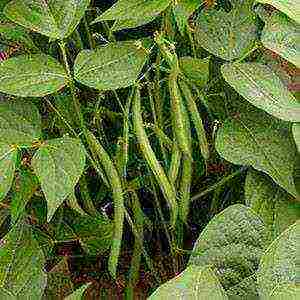
Soils for growing beans can be any soil with the exception of sands. Light loamy soils with a high organic content are most favorable for beans. Loose soil contributes to the creation of optimal heat and air conditions for the growth of legumes.
Predecessors
Beans grow well after vegetable crops: tomatoes, potatoes, cucumbers and cabbage. Feel good after continuous sowing of wheat or corn. But replanting after legumes - beans, soybeans, peanuts, peas or clover - will give a poor harvest. Re-sowing beans after such predecessors is possible only with a three-year break.
Sowing preparation and sowing timing
Bean seeds retain their germination ability for only 2-3 years. Before planting, they are soaked in a damp cloth or simply in water at room temperature until they swell or even peck the sprout.
Seeds germinate at soil temperatures above 2 ° C. The optimal sowing period is considered to be the period from late May to early June, when the soil warms up above 8 ° C. But under favorable weather conditions, sowing is possible at the end of April. In order for the seedlings to be friendly, the planting material is sown in well-moistened soil.
Landing in the ground
The beans are planted either with soaked seeds or seedlings.If it is possible to drive out 30-day seedlings with hardening in a greenhouse or under a film, then they are planted after the May frosts in open ground in a wide-row way. The distance between the seedlings is 10-15 cm, the row spacing is 40-50 cm. It is convenient to plant the beans in a checkerboard pattern of 50x30 cm with seed placement on light soils up to 7 cm deep, and on heavy soils - up to 5 cm. After planting, the soil on the site mulch.
Care
Since beans are a moisture-loving crop, the main care for them is reduced to periodic watering and loosening of row spacings to improve the "respiration" of the plant root system and constant weed control. At the moment the 6th true leaf appears in the beans, it is advisable to add nitrophosphate in the aisle. For this, grooves are made, followed by their abundant watering and sprinkling with earth.
Water the beans at least 2 times a week. Particular attention is paid to soil moisture during flowering and bean formation. Watering rate is a bucket of water per 1 square meter.
When re-loosening, the bushes of the beans are spud. After the leaves close in the rows and close the aisles, the loosening is stopped. This usually occurs when forcing bushes to a height of 50 cm.
To slightly shorten the growing season, the tops of the main stems of the plants are removed. In this case, the beans ripen evenly, and it is also a good way to get rid of aphids during the flowering period.
Pests
A spider mite and acacia moth can damage the seedlings of beans and the beans themselves on the bush. It is also necessary to use insecticides at the stage of fruit formation against the pea stalk and downy mildew.
Harvesting
Unripe beans are tastier and richer in nutrients. In terms of ascorbic acid content, beans at this time are comparable to green peas.
Ripe beans are harvested in August or September after yellowed leaves fall from the bush. The beans are dry at this time, their seeds make a noise when shaken. Legume tops are usually not thrown away. If crushed, then it will serve as a good compost for the subsequent harvest.
4 parts: Choosing the beans Preparing for planting Planting the beans Harvesting the beans
Beans are a great plant to grow for beginner gardeners as they are very easy to plant, maintain, and harvest. Beans have added value - they're very nutritious, giving you more and more reason to add them to your garden. Whether you choose to plant regular beans or legumes, bush or curly beans, the process is easy and you will reap the benefits of your harvest as fall arrives.
Part 1 Choosing beans
-
 Explore two different types of beans.
Explore two different types of beans.
In general, there are two common types of beans: regular beans and leguminous beans. Both species can grow in either a curly or bush style, but the bean pods are what sets them apart. Conventional beans are mostly removed from the pod for food, and eaten fresh or dry to store for later. Legumes are eaten in pods, and only fresh (not dried for later use). It is possible to grow different varieties of these beans directly adjacent to each other, because the legumes self-pollinate and will not cross-contaminate each other.
- Popular common beans include hyacinth beans, horse beans, Chinese cowpea, chickpeas, and common beans.
- Popular leguminous beans include legume (green) beans, adzuki beans, mung beans, asparagus beans, and fiery red beans.
-
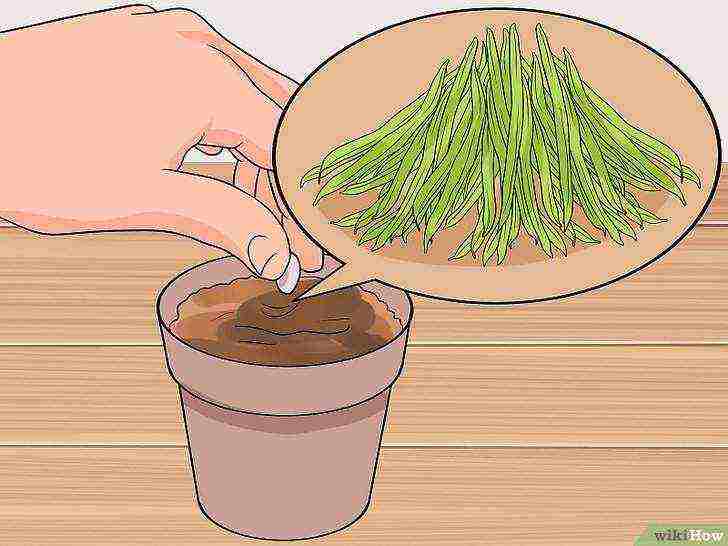 Consider growing curly beans.
Consider growing curly beans.
Curly beans are a type of beans that curl and must be supported by a trellis or peg. Curly beans grow on average 1.5-1.8 in height, and can grow as either regular or leguminous. Curly beans usually grow well in cooler summer temperatures up to 10 ° C in summer. In the United States, they grow well in the northern states.
- You can use any support system (trellis, peg, fence, gazebo, etc.) you want for the curly beans.
-
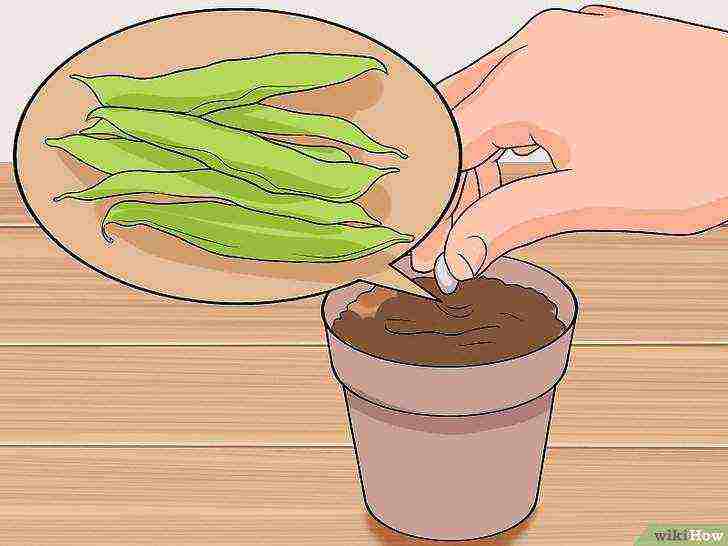 Consider growing a bush bean variety.
Consider growing a bush bean variety.
Bush beans are a type of bean that grows on a bush and do not need a trellis or peg for support. In general, bush beans grow best in warm conditions with summer temperatures of 38 ° C and above. In the United States, they grow well in the southern states. The beans should be planted in long rows, which require much more space than curly beans.
- The bush bean variety called "Half Runner" is a bush / curly hybrid and may require some support or placement near a fence to stabilize.
Part 2 Preparing for Landing
-

Choose a garden plot. Beans are highly adaptable plants that can grow in both sun and shade. If possible, choose a garden area with lots of or partial sunlight. Since curly beans grow up first, only a small amount of space is needed for them. Bush beans grow outward, which means they need a lot more space; choose an area 0.6-0.9 cm wide or whatever you want (for the total number of beans you want to plant).
-

Know when to plant. The beans should be planted after the last frost, usually in the spring months of March and April. Planting too early will freeze and kill the seeds, while planting too late will not give them enough time to germinate and harvest. Check with your local agricultural knowledge office to find out the best planting time for your area.
-

Know how to plant. Beans are one of the few plants that should not be planted as seedlings indoors or transplanted into the vegetable garden. This is because they have a thin root structure that can be easily damaged and may not survive a transplant. As a result, you must sow seeds directly into the ground when spring arrives.
-

Prepare the soil. Beans grow best in soil with good drainage and plenty of nutrients. To prepare the soil, mix the garden compost and top layer of the garden soil in your vegetable garden. Use a hoe to loosen the ground thoroughly and break up any clay-like lumps. Adding compost to the soil will help provide plenty of nutrients to help the beans grow.
-
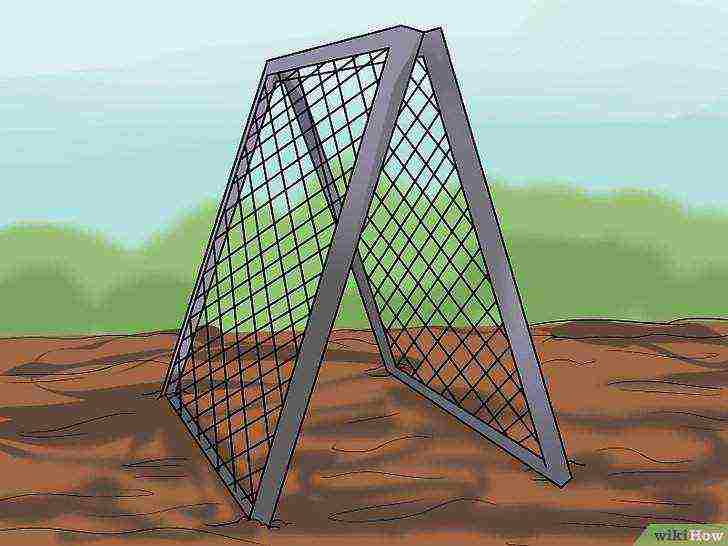
Install the grates. If you are planting curly beans, you will need to set the trellis in the ground before planting the beans. Place a trellis, stick or peg in the exact area where you plan to plant. As the beans grow, they will naturally wrap a structure around them for support. Dig a hole deep enough to stabilize the trellis / peg whether there will be bad weather or strong winds.
Part 3 Planting beans
-
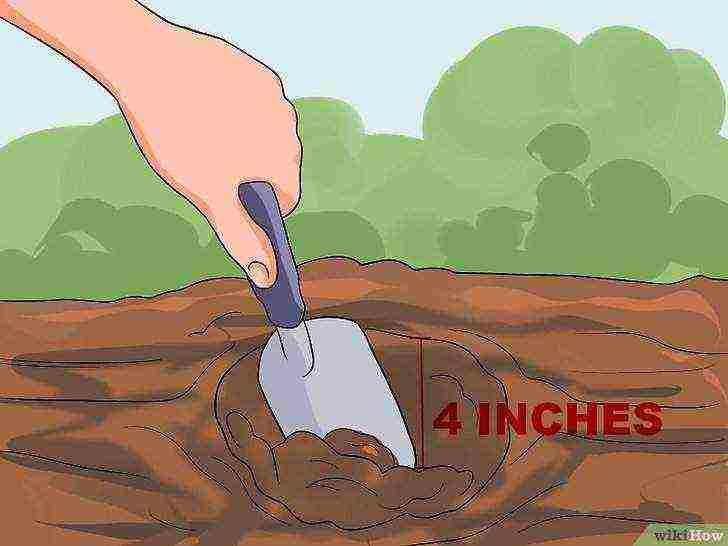
Dig a hole. The curly beans should be planted so that there is one seed per hole and each seed at least 15 cm from the other. Bush beans should be planted with one seed per hole and each seed at least 10 cm apart from the other. The hole should be 2.54 cm deep.
-

Place the seeds. Carefully place one seed in each hole you dug; It may be tempting to plant multiple seeds at once, but this will cause the seedlings to compete for space and nutrients as they grow, and possibly kill the plant. Cover each seed with 2.5-5 cm of garden soil.
-
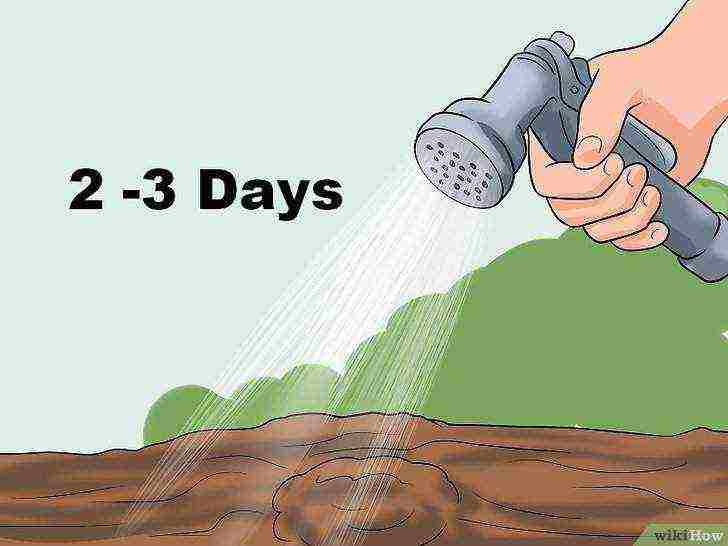
Water your seeds regularly. Immediately after planting, give the seeds plenty of water to help them germinate. After planting, you should continue to water the seeds every 2-3 days, so that the soil is always moist. Avoid over-watering though, as too much water (leaving puddles or pools on top of the soil) will cause the seeds to rot.
-
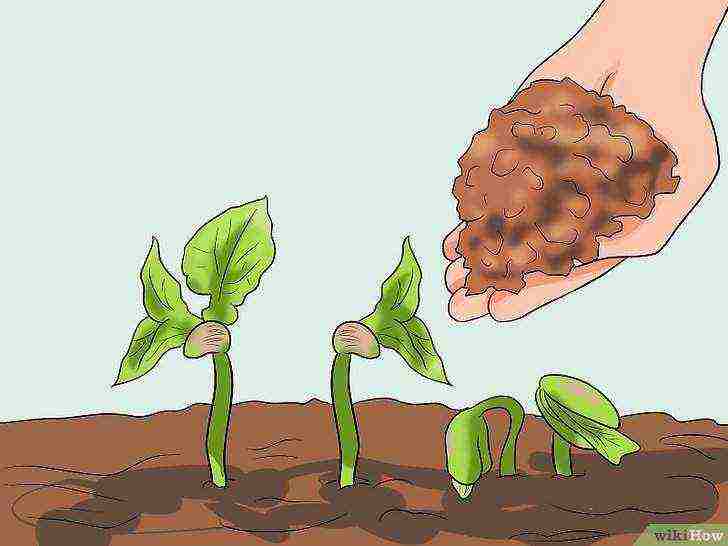
Lay a layer of mulch after the seeds have germinated. Mulch is an incredibly useful tool for new gardeners.Made from compost, mulch is a layer of bark and nutrients that you place on top of the soil in your garden. It blocks the growth of weeds and retains moisture, two good things for new plants. Spread a layer of mulch 2.54 cm thick above the soil after the seeds are 5 cm high.
-

Fertilize your garden every four weeks. Fertilizer adds nutrients to the soil, helping to increase bean growth and overall yield. Fertilizers are made from a combination of three main components: nitrogen, phosphorus and potassium. Beans naturally produce a lot of nitrogen, which means you should look for a fertilizer that is low in nitrogen (like a 5-20-20 mix). Contact your local nursery worker for help choosing a bean fertilizer if you have questions.
Part 4 Harvesting the beans
-
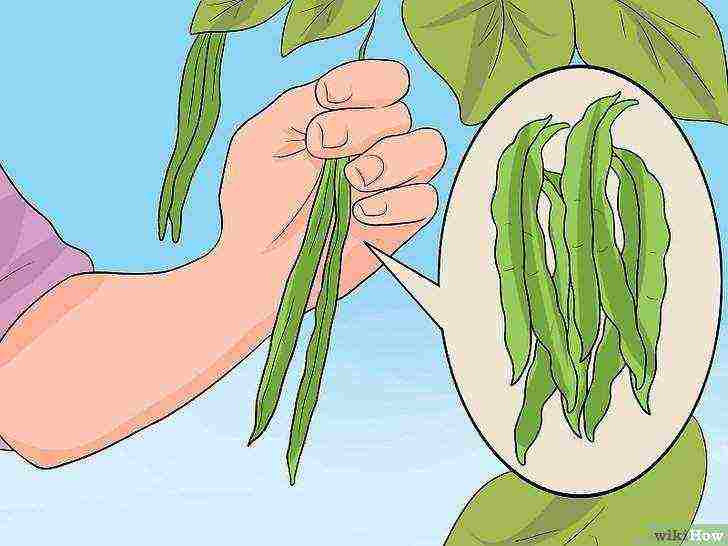
Pull off the bean pods until the pods open. If you want to eat fresh beans, you must harvest them when the pods are large and full. The pods should not show the shape of the beans, because at this stage they begin to dry out. Collect the pods by breaking them off from above; do not tear them as this can damage the plant and prevent new pods from germinating.
-
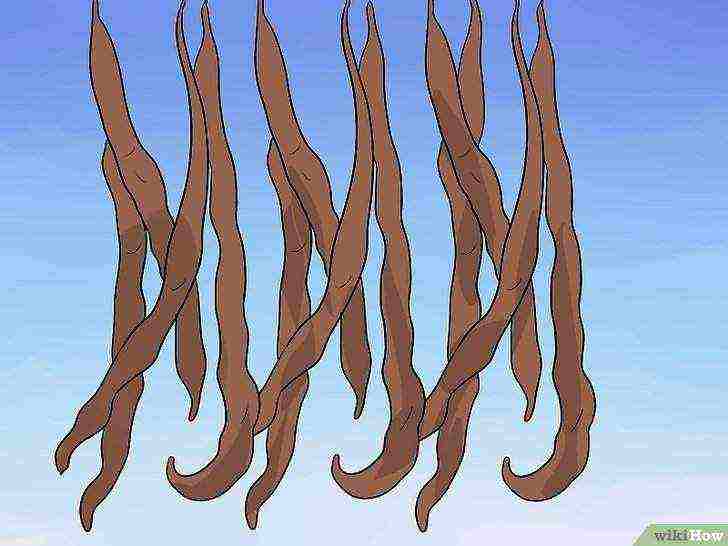
Dry the beans on the plant. If you want to dry the beans for later use, this is an easy process: leave the beans on the plant until they are completely dry. This process usually takes 1 to 2 months after reaching the peak of maturity. You will know when the beans are completely dry and ready for storage as they rattle inside the pods.
-
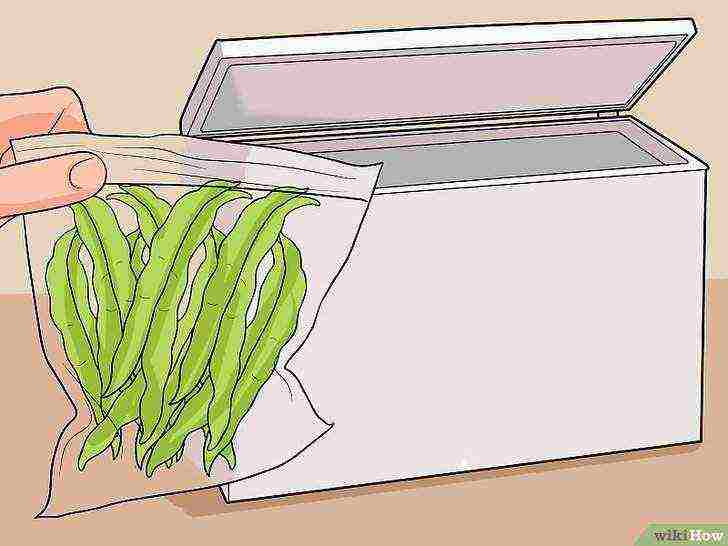
Freeze the beans for later use. Fresh beans can be frozen and used later if you don't want them fresh and don't want to dry them out. Simply place them in an airtight container and place them in the freezer. They will be good for 6-9 months after they are initially placed in the freezer; defrost them, letting them reach room temperature.
Advice
- Tie curly beans to trellises when they are full size for extra support.
Warnings
- Don't keep the soil too dry.
Article Information
This page has been viewed 5,064 times.
Was this helpful?
How to grow beans in the country? The basics of caring for beans: pinching, watering, loosening and feeding!
Buyanov Oleg
Ryabikova boulevard, 50 Irkutsk Russia 664043
+7 (902) 546-81-72 

Date: July 14th, 2016 ||
Heading: Country life and vegetable garden
|| views: 5383
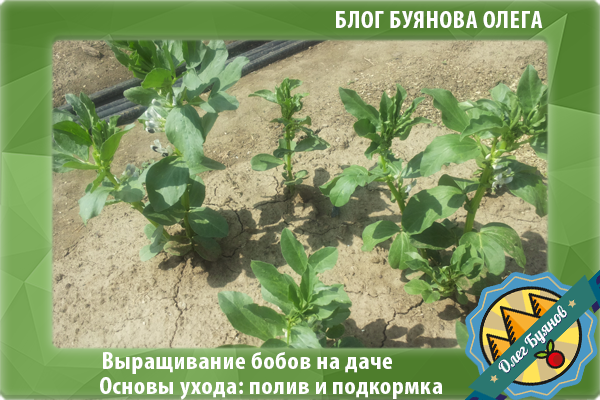
Hello my dear. Continuing the legumes theme. Today I will talk about favorable conditions for growing beans, watering regime, loosening and feeding. You will get acquainted with the basic rules of care and learn how pinching is useful to increase their yield.
To grow beans on your square meters, you do not need to have special knowledge, but still this process has its own nuances. This crop is of particular value as a green fertilizer and a natural source of proteins.
Thanks to the beans, the physical, biological, and chemical properties of soils are improved. The effect on the land of this green manure can be equated to the effect of manure.
Favorable growing conditions.
The most basic favorable conditions for growing include the condition of the land and plant nutrition. Irrigation and soil loosening.
An important factor is pinching, which will help increase the yield and reduce the number of pests.
Condition land for growth.
Our plant is a long day. For its cultivation, areas are suitable, which are the first to be freed from snow in the spring.
Growing up in the country
- The best option for a crop is soil with slightly acidic or neutral reaction, high organic content and high moisture capacity.
- V acidic soils they do not grow well.Light sandy soils are suitable if fertilizers have been previously applied to them and there is no subsoil that easily allows water to pass through, since stagnant water is detrimental to the plant.
- In areas poor soils organic matter, beans act as a green fertilizer. They are rich in nitrogen, which remains in the ground at about 5 g per 1 m² after harvesting plants from the site.
Therefore, it is very useful to grow beans in your summer cottage, thereby increasing the fertile properties and quality of the land for future plantings.
Germination temperature.
It is a cold-resistant crop, so seeds in unprotected open ground begin to germinate at a minimum of 2 ° C. Seedlings survive frosts well down to -4 ° C.
The suitable temperature for flowering and fruiting is 15-20 ° C.
Began to curse
One of the conditions for obtaining a bountiful harvest is compliance with crop rotation. It is recommended to plant them in places where row crops (cabbage, potatoes and others) previously grew.
It is best to plant black beans in a separate bed, but can be combined with other plants as well. In general, it is better to change the planting sites of different crops.
How do I care for beans?
Beans are a plant that is undemanding to special care conditions. Cultivation of culture is an interesting process that requires certain knowledge and skills.
Therefore, in order to obtain a bountiful harvest, it is necessary to carry out the basic care measures: feeding with nutrients, watering, pinching and loosening the soil. I will tell you about these conditions in detail.
Watering.
Plants love moisture. They cannot withstand droughts, even for a short time. For swelling and germination, seeds need 100-120% moisture by their own weight. The best yields are obtained in years when it often rains from sprout to flowering.
If there is not enough rainfall, you need to water the beans more often. Watering plantings should be done every 3-4 days.
The optimal water consumption is 10 liters per 1 m². If the soil and air are dry, the number of fruit set will decrease and the ovaries will fall off. Therefore, pay attention to the amount of moisture in the garden and the amount of precipitation.
Top dressing.
If your plantings do not grow well, they must be abundantly fed with fertilizers. They are given during the first two inter-row treatments.
- As a rule, dry dressings are used ammonium nitrate, potassium salt and superphosphate dry.
- If you apply fertilizing in liquid form, the concentration of the solution should be 3%, that is, 3 g of fertilizer per 1 liter of water.

Growing fast
After this event, you need to water the beds abundantly so that the nutrients are fully utilized by the plants. If your beans grow well, you can do without feeding.
Soil processing.
If the sowing work was carried out in dry weather, after the sowing work, the soil must be rolled up. Three to four days after planting the seeds, harrowing should be carried out, which will prevent the formation of a soil crust and help in weed control.
After emergence, this technique should be repeated when they are in the phase of two leaves and a week after the first. A favorable time for this event is the afternoon.
Harrow immediately after planting and one week after planting. Harrowing along the sprouts is necessary across or at an angle.
Loosening before planting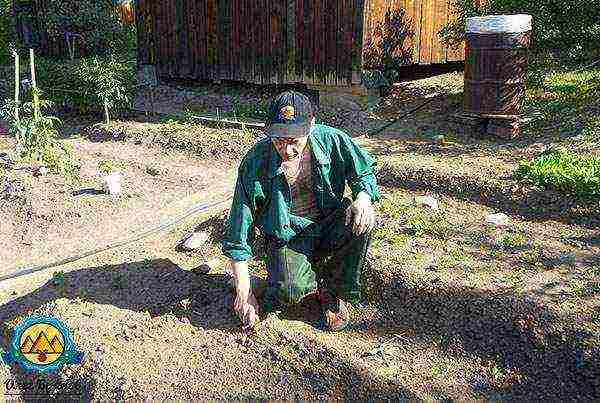
During the growing season, two are usually carried out between row loosening, the third, if necessary: the first - to a depth of 12 cm, the second - to 8 cm.When this procedure is repeated, the plants are spilled for the second and third time.
Topping.
When the beans are formed, the tops of the plants with leaves should be removed, which will greatly accelerate the growth of the fruit.
Also, this agrotechnical technique prevents the appearance of aphids, since first of all it populates the delicate tops of plants. And it will feast on our fruits. Aphids are carried by ants, so you need to pay attention to whether there are anthills nearby.
First flowers
The pinching itself has a beneficial effect on the growth and formation of pods and increases the yield of the beans. And if you are interested in a question about peas, then read my article on growing and caring for peas.
Perhaps they can also be grown at home. But I prefer to practice at my dacha and feast on real Russian black fruits.
- There are also different types of this culture. For example, hyacinth and soybeans, cocoa beans, which are also loved by many. You can read books about the cultivation of these interesting crops. I haven’t come up with these species yet.
That's all. Now you know what the technology of growing beans is. What lands are best suited for planting crops. What is their care, and what is the importance of pinching for growth and a good harvest.
![]()
On this I will end today. I still have a lot to do today. You need to send the first training homework, read, practice speed reading. Think about the strategic development of your blog.
Rating: 5 out of 5 (2 votes)
In our ancestors, beans were one of the main products, so their cultivation was practiced in huge quantities. But the growing popularity of potatoes gradually replaced this culture, first from our dishes, and then from our gardens. And it is completely in vain, because the beans are unpretentious, and the care is minimal, while they are very useful in nutrition.
About beans and their varieties
As a garden crop, Russian beans are undeservedly forgotten, because their cultivation has a lot of advantages: simple care, cold resistance, and also the ability to enrich the soil with nitrogen and improve its structure.
Thanks to its stability, caring for it eliminates the need for tying
Yes, and it is worth returning them to the diet, because this product contains more vegetable protein than beans and peas, as well as carbohydrates, fats, vitamins, micro- and macroelements that are so necessary for our body. And to learn the variety of dishes that are prepared from beans, you can learn from Mediterranean, African, Mexican, Chinese cuisines and many others.
Beans can be described as a plant as follows: a thick, hollow stem, sometimes growing up to 1.5 meters in height. Thanks to its stability, caring for it eliminates the need for tying. There are usually no side branches, the leaves are large, smooth. The roots are located quite deep, especially the central one, which allows the plant to extract moisture from the lower layers of the soil. The flowers are beautiful and large, often white with black blotches. The fruits are formed in the form of elongated pods with a dense shell (the valves are several times thicker than those of peas or beans). Up to 7-9 beans ripen in each pod.
Some characteristics may differ depending on the variety:
- Velena - mid-early. Juicy fruits without parchment shell, pods up to 10 cm long with 3-4 beans.
- Russian blacks - medium early, ripens 85-90 days after germination. The stem is 50-60 cm high and is branched. Fruits are flat, dark purple in color, large.
- Belarusian - mid-season, reach maturity 90-110 days from germination. Plant height from 60 to 100 cm. Cream-colored beans, weight of 1000 seeds 1000-1200 g.
- Virovskie - mid-ripening, ripens in 80-90 days to milk ripeness and after 95-100 - to technical ripeness. The stem is 85-100 cm high, the pod is slightly curved with 3-4 beans of light shades. The parchment layer is noticeable.
Video about the beneficial properties and care of beans
Growing according to all the rules
For planting beans, the most illuminated area is chosen. Soil moisture is also very important, therefore, lowlands or aisles of other beds are often allocated for legumes, which makes maintenance easier. The structure of the soil is not fundamental, beans can grow even on heavy loams, the main thing is that the soil is rich in organic matter. Therefore, the agricultural technology of beans, first of all, involves the application of fertilizers.In autumn, compost, manure, mullein or humus are introduced for digging. Poultry droppings are not recommended for beans due to their high nitrogen content. But they need phosphorus fertilizers, so in the fall they enrich the soil with superphosphate.
You can prepare seeds for planting at home. Before sowing, bean seeds should be soaked in hot water (about 50 ⁰C) for a couple of minutes for disinfection. Then it is recommended to treat them with a drug that increases the yield of legumes, for example, Nitrogin. For successful germination and further cultivation, the seeds need good moisture, therefore, if your soil is sandy in the country and dries out quickly in spring, it is better to wet the beans before sowing overnight so that they are saturated with moisture, and their dense shell has become softer.
Video about growing beans
Sowing beans is carried out as early as possible. And do not be afraid that nighttime cold snaps can damage the seedlings, they perfectly withstand even frosts down to -4⁰С. The main advantage of early sowing is the moist soil, which promotes quick emergence. In addition, further care will not require frequent watering.
Bob is the owner of the garden
The benefits of growing legumes in the country are a whole list! And this is not only a harvest of a useful, nutritious and, most importantly, environmentally friendly product. It is not for nothing that beans are considered the owner of the garden, because they bring considerable benefit to the soil, neighboring crops, as well as plantings of the next year.
Planting and leaving video
It should be noted the main reasons why growing them in your country house is necessary:
- Legumes enrich the soil with nitrogen, which means they save you from the need to use artificial mineral fertilizers.
- Beans are considered reliable protectors; during cultivation, they release phytoncides that inhibit the growth of pathogenic bacteria and fungal infections.
- Planting beans improves soil structure and thrives even on heavy, poorly drained soil.
- They help get rid of moles - invisible, but very annoying pests that complicate the care of the beds. It is enough to sow them around the beds and the moles will no longer flatter your vegetables or berry crops.
- Also, the cultivation of these plants is often used as green manure, sowing them mixed with mustard, rye or lupine.
As you can see, there are many benefits from beans, and agricultural technology and care for them are simple, so be sure to sow several rows next spring in your country house!
